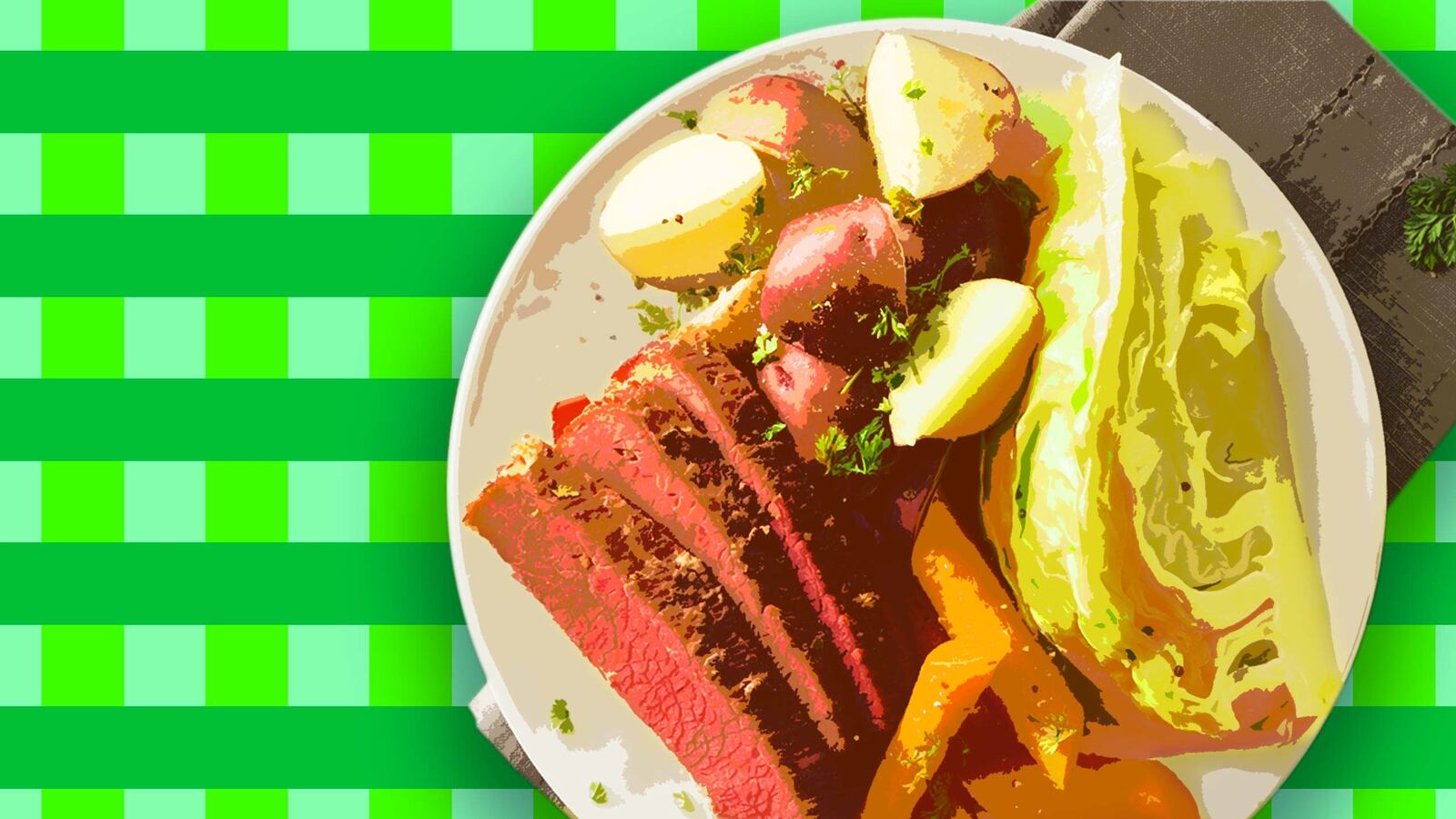I went to college in Dublin for a semester in the early nineties. Basically, all I knew about the country was the music of The Pogues and the joys of Guinness Beer, both of which were hugely important to me at the time. Students have studied abroad for worse reasons. But my simplistic notions of Irish culture led to countless awkward exchanges. When I mentioned something about corned beef and cabbage to my two new Irish flatmates, one of them pounced. “That’s American shite,” he said. “No one eats that.” I liked the other flatmate better.
In America, corned beef and cabbage now exist alongside green beer and leprechauns in our holy trinity of St. Patrick’s Day excess. So how did the dish come to be forever associated with the homeland of my sneering flatmate if no one there eats it?
In 97 Orchard Street, a book that traces the culinary traditions of five immigrant families growing up in a tenement on Manhattan’s Lower East Side in the 19th and 20th centuries, food historian Jane Ziegelman suggests that corned beef and cabbage came to be associated with the Emerald Isle through two sources. However, neither of those sources happened to be located on the Emerald Isle.
For centuries, the dish held no symbolic position in the food chain and wasn’t connected to a specific country. It was simply a hearty and economical meal that sustained the country’s new wave of immigrants from across Europe. Among those immigrants were the Irish, millions of which had scattered across the United States following the potato famine of the 1840s and 1850s. Many had most likely never tasted corned beef until they reached America. “Through a gradual, haphazard process, second- and third-generation immigrants reclaimed corned beef and cabbage as a quintessentially Irish food,” writes Ziegelman.
England first used the term “corned beef” in the 17th century as a nod to the giant, corn kernel-sized salt crystals used to cure meat. Over the next century, much of the world’s corned beef was actually produced in Ireland. Cork, specifically. But the Irish exported it to other European countries, and across the Atlantic, since at the time, the average Irish farmer couldn’t afford to eat it.
Per Ziegelman, Dutch settlers brought corned beef and cabbage to the United States in the early 17th century, and later waves of immigrants arrived with what she calls “their own corned beef traditions.” The Germans sliced it thin and put it on black bread. The Scots simmered theirs with vegetables and added oatmeal to thicken the stock. “Wherever corned beef was eaten,” Ziegelman writes, “cooks developed ways of preparing it that harmonized with local food traditions.”
Like all immigrants, newly assimilating Irish-Americans were caught between the push of their new homeland and pull of the old country. In their new urban enclaves, few could find, or afford, the back bacon they had grown up on. But European Jews had settled in many of the same areas as the Irish, which meant that many of New York’s Irish got their meat through kosher butchers. That meat, ironically, was corned beef, which Jews made from brisket, a tougher cut from the front of the cow. It tasted similar to the Irish’s beloved salted pork. So why cabbage? Again, it was the most accessible and affordable vegetable at the time.
When Abraham Lincoln was inaugurated on March 4, 1861, with the country teetering on the edge of war, his luncheon included mock turtle soup, corned beef and cabbage, parsley potatoes, blackberry pie, and coffee. The comfort food lineup may have been more appropriate for a post-church lunch at grandma’s, but it’s safe to say Lincoln’s populist gesture went over better than his second inauguration in 1865, when drunken midnight revelers, shell-shocked by four years of civil war, demolished a lavish buffet of foie gras, oysters, and bombe a la vanilla.
By the late 19th century, corned beef and cabbage had spread across New York. The unforgettable flavor combination—salty and sweet—seemed to embody the typical Irish disposition. (To say nothing of the tender, forgiving texture.) The dish became a staple of Manhattan restaurants, from modest lunchrooms that ladled massive portions into tin buckets for 15 cents to swank hotel dining rooms like the Fifth Avenue Hotel, where corned beef and cabbage shared the table with pâté de foie gras and beef tournedos with béarnaise. It popped up in hospitals, orphanages, and even prisons. Ireland essentially stopped exporting corned beef because other countries began producing so much of it.
But according to Ziegelman, that’s when corned beef and cabbage went mainstream, thanks to an unlikely source: a comic strip. “Bringing Up Father,” George McManus’s popular American comic that launched in 1913, chronicled the exploits of Jiggs, a newly rich Irish-American who wanted nothing more than to sneak out on his nagging, social-climbing wife, Maggie, to drink and play pinochle with his lower-class buddies at a tavern called Dinty Moore’s. The carousers’ typical meal there—corned beef and cabbage—became a running joke.
The influence of “Bringing Up Father” was enormous. “Maggie and Jiggs’s high jinks inadvertently launched a chain of gastronomic events that transformed both the perception and reality of Irish-American food ways,” writes Ziegelman.
In 1914, a Manhattan saloonkeeper named James Moore, who claimed to be McManus’s inspiration for the comic’s tavern owner, Dinty Moore, opened an Irish steak house and pub in New York’s Midtown theater district. Capitalizing on the comic strip’s popularity, Dinty Moore’s—all stately mirrors and polished brass—drew a distinguished crowd of celebs, athletes, publishers, and politicians. Dinty Moore’s thumbed its nose at the authorities during Prohibition and became a mainstay of Broadway for decades. By the time it closed in the 1970s, the establishment was practically a national monument. Its signature dish led the opportunistic Moore to forever refer to himself as the “Corned Beef and Cabbage King.” (Dinty Moore beef stew, made by the Minnesota-based canned meat retailer Hormel, also cashed in on the establishment’s fame, ultimately enjoying lesser glory but more name recognition.)
By the 1940s, corned beef and cabbage was synonymous with “Irish American,” and had become the mandatory St. Patrick’s Day meal. Simultaneously, it had solidified itself as a lowbrow meal for the working class, a fact that some embraced and others resisted. “Slurring insinuations long have been cast in the direction of corned beef and cabbage,” Mary Meade groused in a 1938 article in the Chicago Tribune. “An unjust whispering campaign has given it the reputation of being a dish too proletarian for the well bred dinner table.” Meade’s defensive prose that follows does little more than solidify its blue-collar position once and for all.
So today, I will, of course, be enjoying plates of corned beef and cabbage. Every bite will perpetuate a misguided tradition with a complicated transatlantic story arc. But, what I wish I had said to my flatmate: Sometimes, almost by accident, history is a winding road that leads back home.






